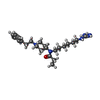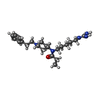+検索条件
-Structure paper
| タイトル | Structure-based design of bitopic ligands for the µ-opioid receptor. |
|---|---|
| ジャーナル・号・ページ | Nature, Vol. 613, Issue 7945, Page 767-774, Year 2023 |
| 掲載日 | 2022年11月30日 |
 著者 著者 | Abdelfattah Faouzi / Haoqing Wang / Saheem A Zaidi / Jeffrey F DiBerto / Tao Che / Qianhui Qu / Michael J Robertson / Manish K Madasu / Amal El Daibani / Balazs R Varga / Tiffany Zhang / Claudia Ruiz / Shan Liu / Jin Xu / Kevin Appourchaux / Samuel T Slocum / Shainnel O Eans / Michael D Cameron / Ream Al-Hasani / Ying Xian Pan / Bryan L Roth / Jay P McLaughlin / Georgios Skiniotis / Vsevolod Katritch / Brian K Kobilka / Susruta Majumdar /  |
| PubMed 要旨 | Mu-opioid receptor (µOR) agonists such as fentanyl have long been used for pain management, but are considered a major public health concern owing to their adverse side effects, including lethal ...Mu-opioid receptor (µOR) agonists such as fentanyl have long been used for pain management, but are considered a major public health concern owing to their adverse side effects, including lethal overdose. Here, in an effort to design safer therapeutic agents, we report an approach targeting a conserved sodium ion-binding site found in µOR and many other class A G-protein-coupled receptors with bitopic fentanyl derivatives that are functionalized via a linker with a positively charged guanidino group. Cryo-electron microscopy structures of the most potent bitopic ligands in complex with µOR highlight the key interactions between the guanidine of the ligands and the key Asp residue in the Na site. Two bitopics (C5 and C6 guano) maintain nanomolar potency and high efficacy at G subtypes and show strongly reduced arrestin recruitment-one (C6 guano) also shows the lowest G efficacy among the panel of µOR agonists, including partial and biased morphinan and fentanyl analogues. In mice, C6 guano displayed µOR-dependent antinociception with attenuated adverse effects, supporting the µOR sodium ion-binding site as a potential target for the design of safer analgesics. In general, our study suggests that bitopic ligands that engage the sodium ion-binding pocket in class A G-protein-coupled receptors can be designed to control their efficacy and functional selectivity profiles for G, G and G subtypes and arrestins, thus modulating their in vivo pharmacology. |
 リンク リンク |  Nature / Nature /  PubMed:36450356 / PubMed:36450356 /  PubMed Central PubMed Central |
| 手法 | EM (単粒子) |
| 解像度 | 3.2 - 3.3 Å |
| 構造データ | EMDB-26313, PDB-7u2k: EMDB-26314, PDB-7u2l: |
| 化合物 |  ChemComp-KZR:  ChemComp-L0X: |
| 由来 |
|
 キーワード キーワード | MEMBRANE PROTEIN / GPCR |
 ムービー
ムービー コントローラー
コントローラー 構造ビューア
構造ビューア 万見文献について
万見文献について







 homo sapiens (ヒト)
homo sapiens (ヒト)
